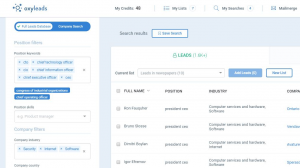With third-party cookies on their way out, here’s how marketers can future-proof data collection and leverage first-party data strategies.
After four years of anticipation, Google officially began restricting third-party cookies for 1% of Chrome users (about 30 million people) this January. This move lays the groundwork for a broader third-party cookie phaseout in the second half of 2024.
Google’s decision to phase out third-party cookies follows a larger market trend — Safari and Firefox deprecated cookies years ago — driven by consumer privacy concerns and mounting regulations. Regulations such as the EU’s GDPR and California’s CCPA force marketers to be more transparent with our cookie-dropping process.
The marketing impact of the death of third-party cookies
To understand how to prepare for this paradigm shift, it’s important to understand the difference between first- and third-party cookies fully.
As a quick refresher, first-party cookies travel back and forth between a user’s browser and a brand’s website, allowing the website to store data about preferences, such as language or login credentials.
In contrast, third-party cookies are placed on a website by a company other than the website’s owner for advertising purposes. These cookies track user behavior on websites, allowing advertisers to customize ad experiences and gauge campaign effectiveness.
As marketers, we have relied on third-party cookies for data to measure and activate campaigns and assess website performance. Third-party cookies have been a common currency marketers could rely on, but that’s changing.
The loss of third-party cookies will inevitably lead to a decrease in the attributable data we have access to. This will decrease the scope and scale of personalized ads, as brands will lose valuable data about their target audiences.
But, the biggest impact the loss of third-party cookies will have on marketers is that we will no longer have a single source of truth for measurement and activation. Marketers will have to multiply solutions to maintain the same level of activation and measurement.
Investing in technical infrastructure to help you activate your first-party data strategy
Marketers need to fill this new data void with other ad-targeting techniques that leverage first-party data, as it is the last exhaustive set of data available. This shift marks a fundamental change in marketers’ approach to data utilization.
Most brands already gather first-party data through direct interactions with consumers on their apps and websites. Still, as third-party cookies become obsolete, it’s now important to do more than just collect data — we need to be able to activate it.
To prepare for a cookie-less future and ensure marketing strategies are privacy-centric and future-proof, marketers need to invest in the technical infrastructures that aim to enhance the use of first-party data now.
1. Secure first-party data collection
Privacy-aware data collection (with CMPs and consent mode)
Consent management platforms (CMP) allow websites or mobile application publishers to set up an interface for collecting user consent easily. These tools display a pop-in window or a banner on the first visit to a site/app, display the different purposes and processors, keep track of users’ choices and implement solutions to respect these choices.
They can also offer platforms beyond the collection and management of cookies by proposing a single management repository for all user consent. CMPs provide you with an enterprise version of consent management and a global view that can accommodate market specifics, all while standardizing consent collection between your website and app.
In light of European regulations, one important consideration is Google’s consent mode, which was recently mandated for companies with European users to ensure user consent is preserved across all the tools that use their data. While currently only mandatory for European marketers, consent mode should be a consideration for all marketers looking to future-proof their tech stacks.
Server-side data collection
Server-side tracking is another step in building a strong, privacy-centric technical infrastructure for your business. The technology sends user data to the company servers before being transferred to the data platform. This makes it easy to control which data is sent to media and analytics partners and can help you comply with heightened browser requirements, resulting in more accurate data collection.
This process is also privacy-compliant and a great way to bridge the data gap. It can also enrich your first-party data by adding data from other sources you don’t want available on a user’s browser (e.g., profit margin) before it gets passed off to outside tools.
Advantages of server-side data collection
- Better control over data. You can control which data is sent to the vendor and how.
- Improved website performance. Speeds upload time as fewer client-side scripts are loaded.
- Improved measurement. It helps extend the lifetime of first-party cookies, avoiding some impact from ad blockers.
- Compliance with GDPR, CCPA and DSAR. You can encrypt, delete, modify or enrich your customer’s data.
Challenges of server-side data collection
- Cross-departmental collaboration. Server-side setup requires alignment between various teams (e.g., marketing, website owners, IT, etc.), which requires strong coordination and planning.
- Complexity. Server-side tracking requires technical expertise to set up and maintain.
- Incompatibility. Server-side tracking is not compatible with every media platform yet.
If your company is looking to improve website performance, future-proof data collection strategies and bolster privacy compliance, server-side tracking offers a scalable and secure solution.
2. Get equipped to leverage your first-party data and be ready for precise activations
Customer data platforms (CDPs) are another crucial tool to leverage when setting up a robust technical infrastructure for privacy-centric marketing. A CDP allows you to utilize your first-party data acquired from server-side tracking, a customer relationship management platform or internal databases to create unified customer profiles.
CDPs offer a more comprehensive view of your customers and act as a central repository of the company’s multiple tools for marketing data. This database can then be segmented in endless ways to create more personalized marketing campaigns.
Advantages of a CDP
- Increased marketing efficiency. Easily communicate with customers on all channels they interact with and provide a consistent message.
- Customer acquisition. Reach potential new customers by leveraging existing customer profiles.
- Advanced customer segmentation. Segment customers more effectively, allowing for more precise customer targeting.
Challenges of a CDP
- Complex setup. Depending on the volume and sophistication of use cases, a CDP can require significant resources, such as engineers and data scientists. This is why the design phase of a CDP implementation is critical to avoid pointless investments. As a reference, a CDP setup generally takes four to six months to complete.
- High cost of entry. CDPs can be expensive to install and maintain.
- Need for quality data. Data quality is key to getting the most out of your CDP. Generally, CDPs require that a company is already collecting good first-party data.
Since CDPs depend on how a company collects customer data, marketers need to invest time on the front end to reap the full benefits of the tool. CDPs are extremely useful for companies with a variety of data sources that are dealing with data silos.
CDPs are a beneficial solution if your company works with large data sets from varied sources and is looking to unify all marketing efforts and provide a more personalized customer experience.
3. Preserve the quality of your data partnerships with privacy through technology
You can think of strong CDP implementation as a good prerequisite for working in data clean rooms, which enable you to connect the first-party data from your CDP to walled gardens like Meta and Amazon.
A data clean room is a secure environment where marketers can create scenarios using first-party data and generalized advertising datasets from media giants like Meta or Amazon. This can give marketers insights that we typically cannot get from using our own limited interface.
Advantages of data clean rooms
- Data sharing. Allows businesses to collaborate or share data in a privacy-safe way.
- Exclusivity. Ability to unlock exclusive insights by gaining knowledge from audiences based on the data clean room provider knowledge.
- Better targeting. Enriches analysis and targeting with advertiser-owned first-party data.
Challenges of data clean rooms
- Price. It can be costly to engage with multiple data clean rooms.
- Data interoperability. Challenges may arise as data clean room query features are restricted to provide anonymity, so analysis can sometimes be constrained. Additionally, it might not be possible to combine data from multiple data clean rooms.
- Implementation complexity. They can be complex to implement and it can be challenging to find the best way to match your data with other data in the data clean room.
Data clean rooms are an emerging solution spurred by the evolving privacy landscape. This solution needs first-party data for activation, so companies must work on the prerequisites before moving on to this solution. However, data clean rooms offer a way to use data in a privacy-safe way without worrying about exposing personally identifiable information.
The journey forward
Many tools that can help you leverage your first-party data in light of third-party cookie deprecation require upfront work and technical expertise but are essential to a future-proofed martech stack.
Implementing these tools early will allow you to test your solutions and work out any kinks. It also allows you to run side-by-side tests to better understand how the loss of third-party cookies will impact your business.
Once you have established the technical infrastructure for privacy-centric marketing, you can consider measurement and activation strategies. The end of third-party cookies is rapidly approaching, so marketers must understand the solutions available to help better collect and activate first-party data and begin investing now.
The post 3 future-proofing strategies for Google’s third-party cookie crackdown appeared first on MarTech.
MarTech(6)
Report Post



